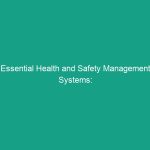Good morning team!
Today, we’re diving into an essential topic that affects each one of us: workplace stress. Understanding how stress manifests in our work Environment is crucial for maintaining our health and Safety. Not only does stress impact our performance, but it also influences our overall well-being and workplace morale. Let’s explore the two main types of workplace stress you must know to create a safer and more productive environment.
Understanding Workplace Stress
Workplace stress refers to the physical and emotional strain that arises from job demands and the pressures associated with them. It’s important to recognize that stress isn’t always negative; some stress can motivate us to meet deadlines or achieve goals. However, chronic stress can lead to serious health issues, decreased productivity, and workplace accidents.
Common misconceptions about stress include the belief that it only affects those in high-pressure jobs. In reality, stress can impact anyone, regardless of their role or industry. Understanding the two primary types of workplace stress—acute and chronic—is essential for identifying and addressing stress-related issues effectively.
Key Hazards, Risks, and Safety Considerations
Both acute and chronic stress present unique challenges and Hazards in the workplace. Here’s a closer look:
- Acute Stress: This type of stress is typically short-term and arises from specific incidents, such as meeting a tight deadline or dealing with a difficult customer. While acute stress can be manageable, it can lead to physical symptoms like headaches, fatigue, and irritability if not addressed.
- Chronic Stress: Unlike acute stress, chronic stress persists over time and can stem from ongoing work pressures, lack of support, or workplace conflicts. The risks associated with chronic stress are more severe, including long-term health issues like anxiety, depression, heart disease, and even accidents on the job due to decreased attention and focus.
Ignoring workplace stress can have real-world consequences, including decreased employee engagement, higher turnover rates, and increased absenteeism. Understanding these risks is the first step in mitigating their impact.
Best Practices, Procedures, & Actionable Advice
To effectively manage workplace stress, it’s vital to implement practical strategies that can be applied daily. Here are some Best Practices to consider:
- Promote Open Communication: Encourage employees to express their concerns and feelings. Creating an environment where staff feel safe to speak up can reduce stress.
- Implement Stress-Relief Programs: Offer resources such as stress management workshops, meditation sessions, or access to counseling services.
- Encourage Regular Breaks: Remind employees to take short breaks throughout the day to recharge. A quick walk or a few minutes of deep breathing can significantly reduce stress levels.
- Foster Team Support: Encourage teamwork and support among colleagues. Building a strong support system can help employees navigate stressful situations more effectively.
For instance, one company implemented weekly check-ins where employees could share their workloads and concerns. This not only improved communication but also allowed management to identify stressors before they escalated.
Regulations, Standards, and Compliance
Understanding and adhering to workplace Regulations is crucial for maintaining safety and well-being. The Occupational Safety and Health Administration (OSHA) emphasizes the importance of addressing workplace stress as part of a comprehensive health and safety program. Compliance with these Standards not only protects employees but also enhances workplace morale and productivity.
Employers should regularly assess workplace conditions and provide Training on stress management and resilience-building techniques. By prioritizing compliance, you foster a culture of safety and well-being.
Employee Engagement & Discussion
Now that we’ve discussed the types of workplace stress and strategies to mitigate them, let’s open the floor for discussion. Here are a few questions to consider:
- What types of stress have you experienced in your role?
- How do you typically manage stress in the workplace?
- What support do you think would help alleviate workplace stress?
Feel free to share your thoughts and experiences. Your input is invaluable in creating a safer and more supportive work environment.
Conclusion & Key Takeaways
In summary, understanding the two types of workplace stress—acute and chronic—is essential for fostering a safe and healthy work environment. By promoting open communication, implementing stress-relief programs, and adhering to safety regulations, we can effectively address workplace stress and its associated risks.
Remember, prioritizing mental health is just as important as physical safety. Let’s work together to create a supportive atmosphere where everyone feels valued and empowered to manage stress effectively.
Thank you for your attention today, and for your ongoing commitment to Workplace Safety. Together, we can ensure that our work environment is not only productive but also healthy and supportive for everyone.


